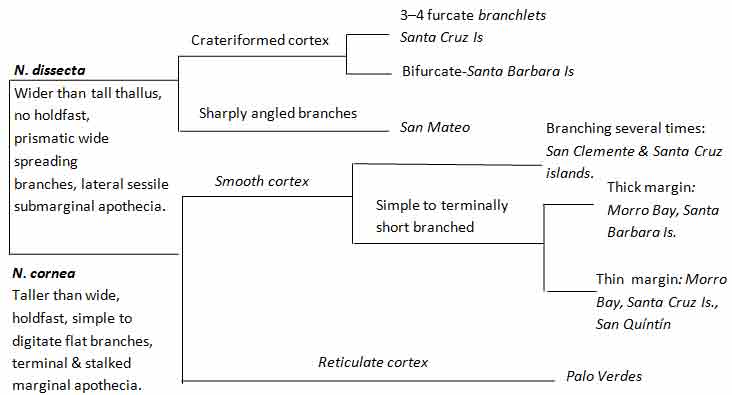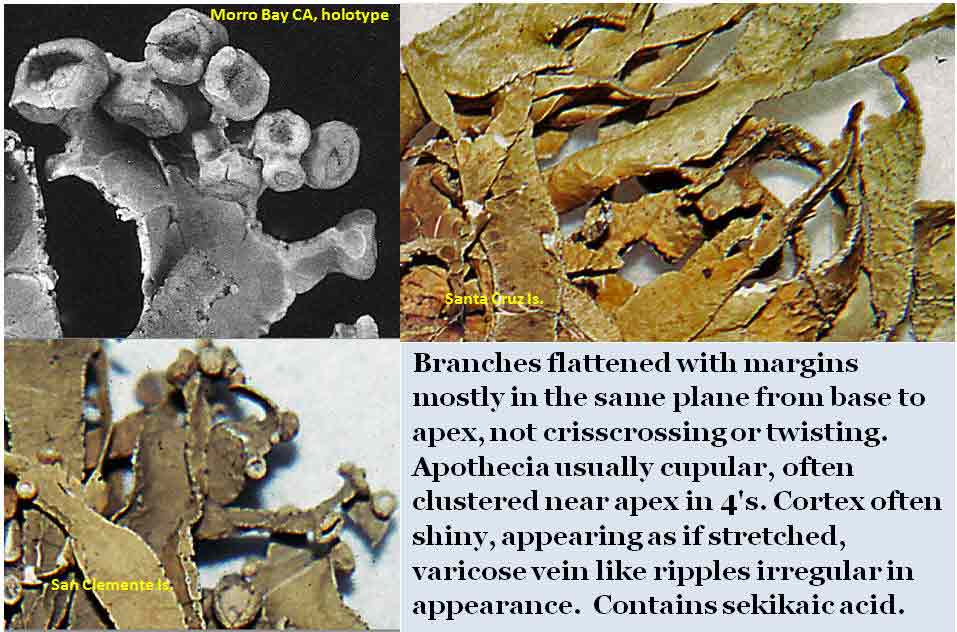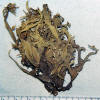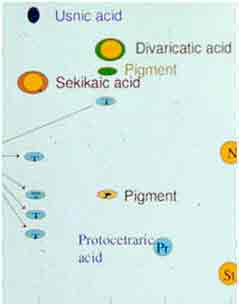Niebla cornea is a fruticose lichen that occurs mostly in California
along the Pacific Coast south of San Francisco, mainland and in the Channel Islands, and in Baja California near San
Quintín. It also was also reported further south
near Punta Santa Rosalillita along Hwy 1. based on a single specimen
found in a sample
of N. flagelliforma (divaricatic acid), that hardly differed from
that species, except for having sekikaic acid. The species is recognized by the flat
but turgid ribbon-like branches—that unlike most other species of Niebla—hardly twist.
This is generally evident by the cortical ridges that define the
primary branch margins ± in the same plane. The primary branches frequently dilate
and
digitately divide near apex into short to long terminal flattened branchlets.
The cortex is ± smooth and glossy, appearing stretched in some thalli to the extent that varicose-like ribs become apparent.
Another distinctive feature of Niebla cornea is the development
of cup-like (cupular) apothecia in small aggregates near ends of branchlets, often in 4's.
Niebla cornea is most similar to
N. eburnea, especially their type
specimens, which are from relatively distant locations, near Cerro Solo (BCN) and
at Morro
Bay (CA). Niebla eburnea is generally distinguished by the primary
branches half-twisted near base and again near apex, by narrower terminal branchlets,
by having a paler cream-like cortex (rarely dark green), by the presence of
the lichen substance divaricatic acid (as opposed to sekikaic acid
in N. cornea),
and by the solitary disciform apothecia that form terminally, or develop on short
subterminal branchlets. The epithets for both species were chosen
for their distinct but similar cortical features.
Niebla cornea
may be confused with Vermilacinia
laevigata, which can be recognized by the shallow recessed
apothecial disk, in contrast to cup-like in N. cornea, the apothecia
usually positioned just below the apex
near the branch margin often on a short lobe extension. Another similar
species, V.
johncassadyi, differs by having branches spreading recurved
and by apothecia developing in terminal aggregates, or appearing
to abort development below apex along the branch margins. The key
identifying features for N. cornea are the presence of medullary chondroid strands and
the depside secondary metabolite, sekikaic acid.
Niebla cornea might also be confused with
N. homalea, which differs by the narrower branches
with margins that frequently alternate or twist
90 degrees from base to apex, and by the lichen substance of divaricatic
acid.
Specimens of N. cornea collected by Charis Bratt (3712)
from Santa Barbara Island and Riefner (86-25) from Morro Bay differ
in the marginal and intermarginal cortical ridges densely covered by pycnidia
and/or nodular apothecia. They are remarkably similar for having
been
collected from disjunct
locations. They appear related to N. lobulata by the
lobulate margins, wavy cortical ridges, and
by the irregular presence of fringed branchlets. They also appear related to
N. dissecta by the thicker cortex and sinuous
cortical ridges, and to a specimen of a
divaricatic-acid species, N. laminaria,
collected from Pt. Loma in San Diego Co. (Bratt 5631), which has
a thallus
divided into short rounded lobes that are also similar to the Riefner specimen (86-25)
except for spine-like segments.
Niebla dissecta differs from N. cornea by
its 3–4 longitudinally ribbed branchlets, and
by the thallus spreading more at the base than in height. This is in
further contrast to the long sublinear branches of
N. disrupta. The relationships of N. cornea 'variants' are
shown in the following dendrogram in
comparison with N. dissecta and its variants.
DNA analyses employing restriction site-a
DNA sequencing (RADSeq) that selected 40
specimens representing 22 species and one variety (sensu Spjut 1996) supported N cornea
for specimens collected in the Channel Islands
(Santa Barbara, San Clemente) and near San Quintín in Baja
California (Jorna et al., see Leavitt citation above). A
morphological dendrogram for N. cornea as it relates to N.
dissecta, a species endemic to California, type from San Mateo
County, is shown below. DNA have not been obtained for N. dissecta.

For more discussion
and reference materials see Introduction to Niebla














